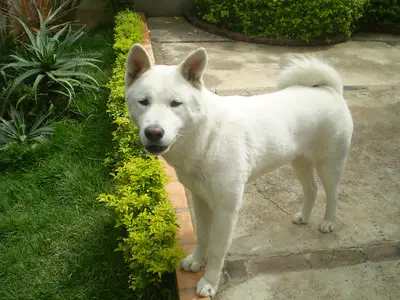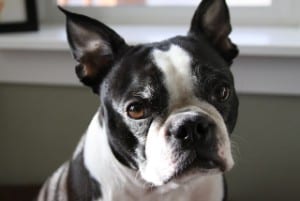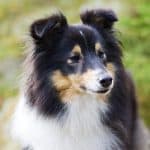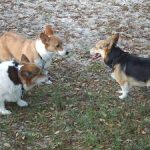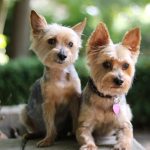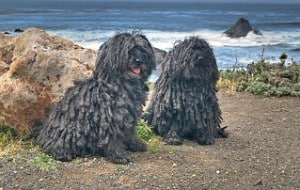
So you fancy a dog with curly ears?!
Dogs that have curly ears normally have curly coats as well.
Of the hundreds of different breeds of dogs, there are actually only seven different types of dog coats (or phenotypes)- three of which are curly.
And that it wasn’t until the summer of 2010 that scientists found out exactly what it is that makes a dog’s coat curly.
It is caused by a mutation in a gene called KRT71.
Most of this article is devoted to introducing you to eleven different dog breeds that have curly ears.
But before we get to that, I want to talk more generally about curly haired dogs.
Pros and Cons of owning a curly haired dog
Any type of dog has a list of possible advantages and disadvantages that comes from owning them compared to other types of dogs.
For instance, big dogs vs small dogs or long haired dogs vs short haired dogs.
So the obvious comparison with a curly haired dog is with a dog with straight hair.
And a drawback of having a curly haired dog is that they should be groomed more regularly than a dog with straight hair in order to keep their hair as tangle free as possible or to untangle all of those small sticks or branches from their coat!
Are curly haired dogs hypoallergenic?
Here are two interesting facts about dogs and allergies…
It is thought that between 10%- 20 % of the world population is allergic to dogs.
Did you know that there isn’t any breed of dog that is guaranteed to not trigger any allergies?
In other words there isn’t a dog breed that is 100% hypoallergenic.
Instead, you should consider all breeds of dog as being on a spectrum that at one end has breeds that are least likely to cause allergies and at the other end has breeds that are most likely to cause an allergy.
Of the group of dogs that are most hypoallergenic are breeds with curly coats and this is for two reasons: curly coated dogs don’t tend to shed their hair and curls in the coat tend to trap the dander that causes so many allergies.
[1] Curly Coated Retriever:
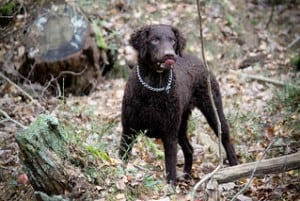
The Curly-Coated Retriever, known to be one of the oldest retriever breeds, definitely lives up to its name. Its tightly curled coat makes the Curly-Haired Retriever water-proof and thorn resistant.
The only place on the dog without curls is around it’s face.
The same tight curls that are on its body are on its ears as well.
They have a beautiful shiny coat, coming in a sleek black or liver colour.
Curly-Coated Retrievers are also known for their wedge-shaped heads when compared to other retrievers.
The Curly-Coated Retriever was initially bred for water retrieving and to be a gun dog. Because of this, Curly-Coated Retrievers are elegant, graceful, and require a TON of outdoor exercise.
Like other retrievers, they love to play with family members outside and are good family dogs in general. Unlike other retrievers, however, Cult-Coated Retrievers are more independent and less needy.
A Curly-Coated Retriever is also a big dog, growing up to 26 inches (66cm) in height, and weighing up to 70lbs (32kg).
[2] Komondor:
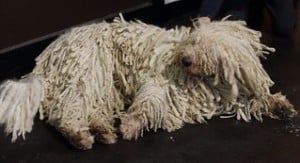
dreadlocks ³
The Komondor is a very distinctive and recognizable dog breed characterized by copious amounts of white coiled cords dangling from its body, similar to dreadlocks.
These cords cover every inch of their body including their ears and tail.
But they aren’t born with them, instead these thick cords develop sometime around the age of two years old.
Komondors are powerful dogs that can weigh over 100lbs (45kgs) and stand 28 inches (71cm). They require little exercise to be kept happy and love to follow their owners around the house.
Komondor’s mop-like coats are specialized to protect the dog from extreme weather and fierce predators. Komondor originated from Hungary and was bred to protect sheep herds, making them great farm dogs.
This fact also makes Komondors very protective of their family and very loyal. Komondors are also brilliant and independent, so they make very dutiful companions.
Although they are a great family dog, the Komondor is not very common.
It is estimated that the worldwide population of Komondors is less than 10,000, with most of the population living in either Hungary or the United States.
Komondors also appear in other lists that I have created.
[3] Puli:

only thicker! ⁴
Like the Komondor in coat, the Puli also has a dreadlock-like fur with long curls that come down from its body and ears.
Pulis were originally bred to be a herding dog, meaning they are knowledgeable, independent, and loyal. Puli’s will often even try to herd people by nipping at their heels!
Pulis are also known for their outgoing dispositions. They can make great companions and family dogs.
The Puli’s curly coat comes in a variety of colours such as black, rusty black, gray, and even white. A Puli’s fur generally is very high maintenance, however. Hence, if you are thinking of bringing a Puli into your family, be aware of this. Otherwise, you might have a nightmare on your hands!
A Puli stands at around 17 inches (43cm) tall and weighs about 35lbs (16kg). Therefore, they can be classified as a compact herding dog.
[4] Poodle:
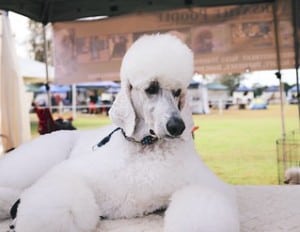
Poodles are probably one of the most famous dog breeds ever known. A show poodle’s coat may be manicured into numerous extravagant styles, allowing their curls to be shown off to the world. Besides being known for their show-dog hairstyles, Poodles are also known to be fun-loving family dogs that are lively and love to play. Poodles are also known for their intelligence and their ability to be trained easily.
Poodles can come in various colours, including white, black, gray, blue, silver, brown, and apricot. Poodles also come in varying sizes. The standard is over 15 inches (38cm) tall and weighing up to 70lbs (32kg). A miniature poodle may be up to 15 inches (38cm) tall and weigh up to 20lbs (9kgs). A toy poodle will be less than 10 inches (25cm) tall and weigh up to 7lbs (3kgs).
[5] Bichon Frise:
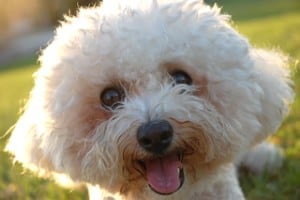
The Bichon is a small dog that is a mass of long wavy white hair that covers it’s body.
It’s ears are wavy, its tail is wavy and so are it’s legs.
The Bichon Frise is a wonderfully cheerful, loving, and smart dog breed. They are small dogs, up to 12 inches (30cm) in height and 12lbs (5kg) in weight, and are perfect for apartment living.
Bichon Frises are known for curly white coats and ears, and the puff of hair on top of their heads.
Besides having a white coat, a Bichon Frise may also have shadings of cream, buff, or apricot in their coats. However, their coats need considerable care, so keep that in mind if you want to bring a Bichon Frise into your home.
Bred to be companions, now Bichon Frises serve as adorable dogs who are active, gentle, and even good with kids. Bichon Frises, since they are small dogs, also do not need a lot of exercises to be happy. Just try to give them at least 20-40 minutes of playtime per day.
[6] King Charles Spaniel:
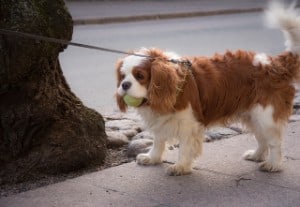
The Cavalier King Charles Spaniel, or King Charles Spaniel for short, is very similar to its cousin, the Cocker Spaniel.
King Charles Spaniels are characterized by their sweet faces and big eyes.
This dog has one of the “loosest” curls of any on my list.
Curls that are as “loose” as this have quite a messy look.
And these curls are on their ears and around the stomach and tail of a Cavalier.
Their coats are also very soft and flowy.
Generally, King Charles Spaniels are gentle and affectionate, yet athletic and playful. They are lovely dogs, with a regal air that surrounds them wherever they go.
They were initially bred to be companion lap dogs for royalty, so descendants of ancient King Charles Spaniels still carry that air of aristocracy with them. Since they love to sit, they require little exercise: less than 20 minutes per day.
Generally, a King Charles Spaniel will reach 13 inches (33cm) in height and 18lbs (8kgs) in weight. They also come in various colours: red, red and white, black and tan, and tricolour.
[7] Bedlington Terrier:
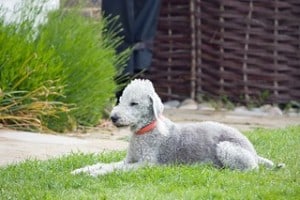
The most distinguishing feature of the Bedlington Terrier is the fact that they look almost identical to lambs.
They have a coat made up of “tight” or small curls that extend from their noses to their tails.
These curls are even all over their floppy ears, unless the Bedlington is destined for the show ring.
In which case, the main part of their ears will be shaved leaving a cotton puff tip- it looks like a ball of wool.
This mischievous breed was initially bred for killing rats, badgers, and other vermin. So, be sure to give it plenty of exercise to lower the risk of bad behaviour due to boredom. Between 20-40 minutes of exercise per day should suffice.
Bedlington Terriers are also known for their distinctive head shape. With a jaw that is longer than the skull and a distinctive “Roman” nose, the Bedlington Terrier is one unique pooch!
The average Bedlington Terrier will stand 16 inches (41cm) in height and weigh up to 23lbs (10kgs). Besides being white coloured, Bedlington Terriers can also come in blue, blue with tan, sand, sand with tan, and liver.
[8] Irish Water Spaniel
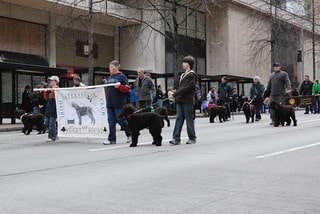
amazing “liver” colour ⁹
This breed is characterized by its curly mop of hair covering its entire body, head, and ears.
The coat is a very loose wave through the hair rather than a curl- it reminds me of a bad perm that you could get in the 1980’s.
It has medium length curls that are generally a solid liver (or brown) colour. An Irish Water Spaniel’s coat is also very high maintenance and needs a lot of grooming.
The Irish Water Spaniel is also known to be the “Clown” of the Spaniel family because of its silly behaviour.
It loves to play in the water and chase after ducks. As well, the Irish Water Spaniel is a devoted companion to its owner and a highly intelligent and curious animal.
Irish Water Spaniels are on the larger side, grow up to 23 inches (58cm) in height, and weigh up to 65lbs (29kgs). They are also very high energy dogs that need a lot of exercises. Typically, an Irish Water Spaniel will need more than 40 minutes of playtime and exercise per day.
[9] Portuguese Water Dog:
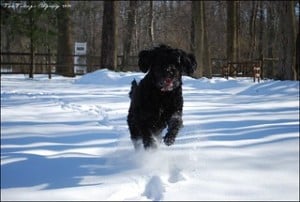
regularly to stop their curls tangling. ¹⁰
These dogs have an amazingly thick and dense coat. Their hair is very long and it is more wavy than tight curl.
These dense wavy hairs extend all over the dog’s body, from the top of the head down.
In fact it is so long and thick that a Portuguese Water Dog’s ears are lost amongst it
Known to be affectionate, adventurous, and athletic, the Portuguese Water Dog is also a super-smart, easy-to-train, eager-to-please pup.
The Portuguese water dog is ideal for owners who want a medium-sized, active dog that is playful and fun to have around the house.
Portuguese Water Dogs are also a great family dog as they get along well with kids.
Originally, Portuguese Water Dogs were meant to help aid hunters and anglers retrieve game from the water. However, they were mostly used to herd fish into nets and retrieve anything that fell into the water.
Because of this, they are highly energetic dogs that require many exercises a day, so keep this in mind!
Their medium-length coat is characterized by white, black or brown curls covering the entire body, face, and ears. Their overall grooming needs are very high due to the number of tight curls that cover their bodies.
A Portuguese Water Dog will grow up to 23 inches (58cm) in height and weigh up to 60lbs (27kgs).
[9] Barbet:
Barbets are covered from head to toe in medium length curls, which usually is a brown colour. However, Barbets also come in other colours: black, white, fawn, and grey.
Barbets are known to be friendly, intelligent, and sweet. This dog breed makes for an adorable looking and affectionate companion with their curly coats and soft fur.
Barbets are quite agreeable when it comes to training and need regular exercise to satisfy their needs. Because Barbets were bred to be a marsh or swamp game retriever, the Barbet is one of the more agile dog breeds and loves to swim. They also love to play in large outdoor spaces and be taken on several walks a day.
Barbets are larger dogs, grow up to 25 inches (64cm) in height, and weigh up to 65lbs (29kgs).
[10] Lagotto Romagnolo:
The Lagotto Romagnolo, although hard to pronounce, is definitely an easy pick if you are looking for a companion that is adorable, intelligent, and independent.
Originating in Italy, the Lagotto Romagnolo is characterized by the woolly curls covering its entire body and the gorgeous beard and bushy eyebrows that adorn its face. The curls covering its body can sometimes feel more like human hair, rather than fur.
Although they look like teddy bears, the Lagotto Romagnolo was bred for strength and endurance, so do not be surprised at how fast and agile this dog breed is. Lagottos are also a medium-sized dog breed that will grow up to 20 inches (51cm) in height and weigh up to 35lbs (16kgs).
The Lagotto Romagnolo comes in a variety of colours, such as brown roan. White, chocolate, off-white, orange, or a mix of these colours.
[11] Bouvier Des Flandres:
As the name suggests, this dog breed originated from France, where they were put to use as cattle herders, work dogs, and watchdogs. This breed is characterized by its large size, barrel chest, wide gait, and medium-length curls covering its entire body. Although curls cover its whole body, however, their ears are floppy and have fewer coils.
Since this dog is so big, they are generally not considered “grown” until 2 or 3. This dog breed will weigh up to 90lbs (41kgs), and grow up to 36 inches (91cm) in height. Generally, the Bouvier des Flandres is an energetic dog that can keep up with all the house excitement. They are happiest when they get a lot of exercises, and they love running, hiking, and biking with their owners. Keep this in mind if you are thinking of adopting a Bouvier.
Photo Credits
² Photo by Mattias Agar on Flickr
⁴ Photo by Anita Ritenour on Flickr
⁵ Photo by VirtualWolf on Flickr
⁷ Photo by Joakim Honkasalo on Unsplash
⁸ Photo by localpups on Flickr
⁹ Photo by Steve Voght on Flickr
¹⁰ Photo by Five Furlongs on Flickr

